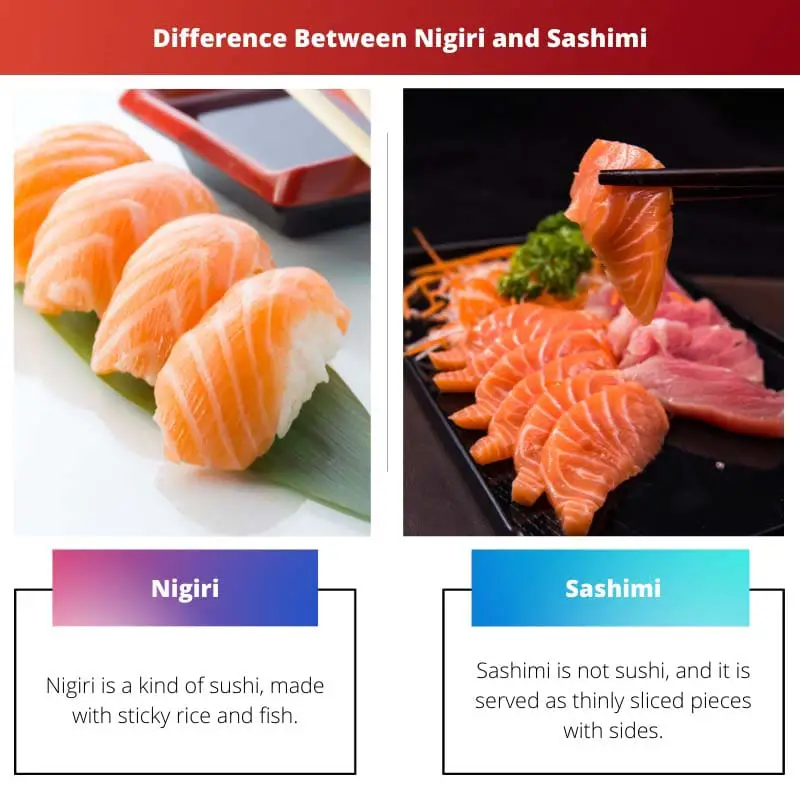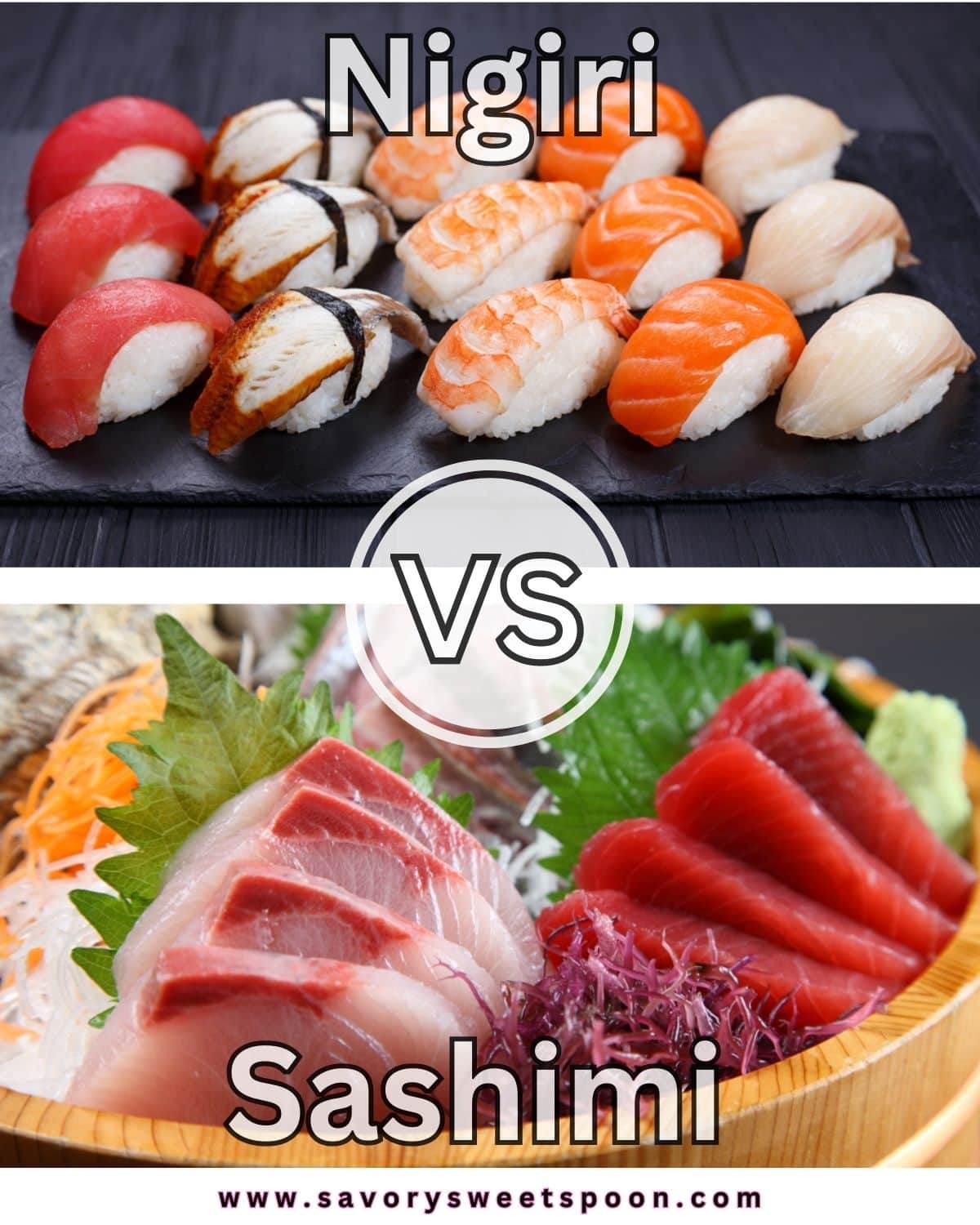Nigiri Vs. Sashimi: Unveiling The Differences In Japanese Cuisine
Are you ready to navigate the captivating world of Japanese cuisine, where the delicate dance of flavors and textures creates an unforgettable dining experience? The distinction between nigiri and sashimi, two cornerstones of Japanese culinary art, often perplexes newcomers, but understanding their core differences is the key to unlocking a deeper appreciation for these exquisite dishes.
These two dishes, both involving raw fish, represent distinct approaches to showcasing the ocean's bounty. Nigiri, a type of sushi, marries meticulously prepared vinegared rice with a topping of expertly sliced raw fish or seafood. Sashimi, on the other hand, presents the unadulterated purity of the fish, offering thinly sliced portions of raw seafood, without any rice accompaniment.
The fundamental difference lies in the presence or absence of rice. Nigiri features a carefully molded portion of sushi rice, a blend of short-grain rice seasoned with vinegar, sugar, and salt. This rice serves as a base, a counterpoint to the rich flavors of the fish. Sashimi, in contrast, eschews the rice altogether, allowing the inherent qualities of the fish to take center stage. Its appeal lies in the purity of flavor and texture.
Let's delve into a comparison that breaks down the nuances of these two iconic Japanese dishes.
| Feature | Nigiri | Sashimi |
|---|---|---|
| Main Ingredient | Vinegared rice with topping of raw or cooked fish/seafood | Thinly sliced raw fish or seafood |
| Rice | Yes, a small, hand-pressed portion of seasoned sushi rice | No rice |
| Preparation | Rice is molded, often with a dab of wasabi. Fish is sliced and placed atop the rice. | Fish is carefully filleted and thinly sliced, often with attention to presentation. |
| Garnishes | Often includes wasabi between rice and fish. May include other garnishes like pickled ginger. | May include wasabi, soy sauce, pickled ginger, and decorative elements such as daikon radish or shiso leaves. |
| Presentation | Typically served in pairs or sets, with fish artfully arranged on the rice. | Arranged beautifully on a platter, showcasing the color and texture of the fish. |
| Flavor Profile | A combination of the flavors of the fish and the seasoned rice. | Focuses on the pure flavor and texture of the fish, often highlighting its natural sweetness or richness. |
| Cultural Usage | Often a part of a larger sushi meal. A classic sushi preparation. | Sometimes served as an appetizer or a standalone dish to appreciate the quality of the fish. |
| Common Fish Types | Salmon, tuna, yellowtail, shrimp, eel, etc. | Salmon, tuna, yellowtail, sea bream, scallops, octopus, etc. |
| Cost | Generally more affordable than sashimi due to the use of rice. | Can be pricier, depending on the quality and rarity of the fish. |
| Types | Variety of fish and seafood. | Generally limited to different cuts and varieties of raw seafood. |
The art of preparing nigiri involves several key steps. The sushi chef starts by molding a small, oval-shaped portion of sushi rice, expertly seasoned with vinegar, sugar, and salt. Often, a tiny dab of wasabi is placed on top of the rice to enhance the flavor and act as an adhesive. The carefully sliced piece of raw fish or seafood is then draped over the rice, completing the nigiri.
In contrast, preparing sashimi is all about precision and respect for the fish. The chef carefully selects the freshest, highest-quality fish, considering factors like fat content and texture. With a sharp knife, the fish is expertly filleted and thinly sliced, often at a specific angle to showcase its beauty and enhance its texture. The slices are then artfully arranged, often on a bed of shredded daikon radish or shiso leaves, to provide a visual appeal and enhance the overall dining experience.
The selection of fish is, of course, another crucial element. Nigiri offers a wide variety of fish, each bringing its own unique flavor and texture to the experience. Popular choices include salmon, with its rich, buttery flavor and smooth texture; tuna, ranging from the light sweetness of pink tuna to the intensely flavorful otoro (fatty tuna belly); and yellowtail, offering a clean, slightly sweet taste. Other popular options include shrimp, eel, and various shellfish, each contributing to the diversity of nigiri.
Sashimi, on the other hand, is often a showcase for the finest cuts of fish. The options are extensive, from the familiar salmon and tuna to more specialized choices like sea bream, scallops, and octopus. The presentation of sashimi highlights the natural beauty of the fish, allowing its inherent flavors to shine through. The quality of the fish is paramount, ensuring a pure and unadulterated experience.
The garnishes accompanying both nigiri and sashimi play an essential role in enhancing the dining experience. Wasabi, a pungent green paste made from the wasabi plant, is a staple, offering a fiery kick that complements the richness of the fish. Pickled ginger, or gari, acts as a palate cleanser, preparing the taste buds for the next bite. Soy sauce is often used to season both nigiri and sashimi, with the diner dipping the fish into the sauce before consumption.
When enjoying nigiri, it is customary to dip the fish-side into soy sauce, avoiding getting the rice too wet. Some diners prefer to eat nigiri in a single bite, while others may carefully separate the fish from the rice. Sashimi is often eaten by dipping each slice into soy sauce and enjoying it on its own or with a small amount of wasabi.
The origins of sushi and its variations like nigiri and sashimi can be traced back to ancient Southeast Asia, where fish was preserved in fermented rice. This method, designed to prolong the life of the fish, gradually evolved into the culinary art form we know today. The use of vinegared rice, a crucial component of nigiri, was developed later, transforming the dish into a fresh and delicious experience.
The presentation of nigiri and sashimi also reflects a deep appreciation for aesthetics. Chefs meticulously arrange the dishes, often using decorative elements like daikon radish, shiso leaves, or edible flowers. The goal is to create a visually stunning presentation that enhances the overall dining experience. The beauty of the arrangement is as important as the quality of the ingredients.
The price of nigiri and sashimi can vary greatly depending on the restaurant and the quality of the ingredients. Nigiri, with its use of rice, is often more affordable than sashimi. Sashimi, especially when featuring premium cuts of fish, can be more expensive. The price also reflects the skill of the chef and the overall dining experience.
While both nigiri and sashimi are exceptional representations of Japanese culinary art, they serve distinct purposes. Nigiri combines the flavors and textures of fish and rice, while sashimi showcases the unadulterated purity of the fish. Both are wonderful ways to explore the world of Japanese cuisine.
Choosing between nigiri and sashimi often depends on personal preference. If you are looking for a balanced experience with a variety of flavors and textures, nigiri is an excellent choice. If you want to appreciate the pure flavor of the fish, sashimi may be more your style. Both are great starting points for those looking to try japanese cuisine.
The term "nigirizushi" specifically refers to nigiri sushi. It is made by placing thin slices of raw fish atop pressed sushi rice.
Both dishes are often accompanied by traditional garnishes, such as wasabi, pickled ginger, and soy sauce. These garnishes enhance the overall dining experience and complement the flavors of the fish.
Nigiri's association with sushi also means that it can be considered one of many forms, even though it stands apart as a unique experience. The seasoned rice is a significant component of sushi, and the flavors of the fish combined with this rice create a unique taste.
Both dishes are often served in Japanese restaurants and are considered a part of any full japanese menu. The terms are sometimes used in comparison to each other, which is a good start.


